| 1 | Africa’s most fabulous viper |
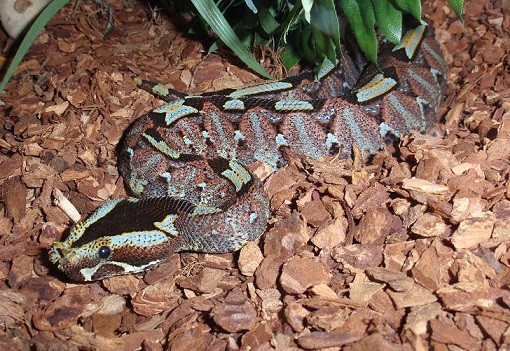
The butterfly viper isn’t the deadliest viper on Earth (the Russell’s viper), nor the largest like the South American bushmaster. But it does achieve one record: being the most fantastically colourful. Butterfly vipers are a species of central Africa, where they’re abundant in Uganda, DRC and Nigeria. They’re a member of the Bitis viper family, which has 18 members, and contains the puff adder (Bitis arietans), the species responsible for the greatest snakebite fatalities in Africa annually.
This is a lazy snake which nestles itself in root hollows, below fallen branches, and within dense foliage to use ambush tactics. Butterfly vipers (Bitis nasicornis) are sluggish and stay in place for days, yet can strike with lightning speed, travelling over half their own body length in one leap. Butterfly vipers usually hold onto their prey for several minutes before swallowing, allowing their venom to spread through every capillary.
This extreme speed also applies in defensive strikes, i.e. an explorer venturing into the rainforest to search for a new snake species, only to meet a very old one, to his dismay. Luckily, this species causes just a tiny fraction of the puff adder’s deaths per year, due to preferring deeper forest locations.
| 2 | Jagged horns and jagged scales |
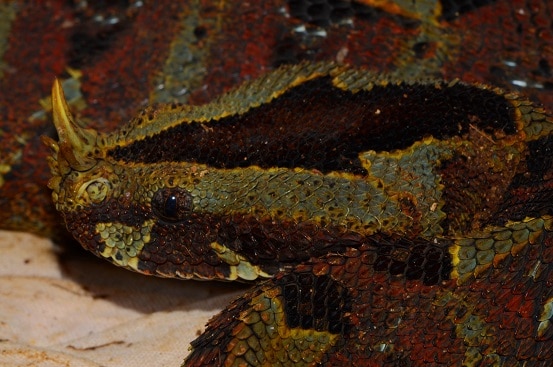
Butterfly vipers inhabit only central Africa, coming nowhere close to the likes of South Africa and Zimbabwe. To the east, their range reaches far western Kenya. To the west, their territory ends in Sierra Leone, after passing through Ghana and the Ivory Coast. Butterfly vipers overlap with several of their Bitis relatives, such as rhinoceros vipers in west Africa and gaboon adders in the central and eastern zones.
While exceptionally thick, particularly for a non-constrictor, butterfly vipers only average at 80-100cm, with an all-time record of 120cm. The clearest ID sign is the three-pronged horns springing out of its nose. Its body scales are also strongly keeled, growing ever sharper as you move up the sides to the spinal column. Each individual scale has a small notch to accommodate the keeled tip of the scale behind.
Butterfly vipers are multi-skilled, as they’re excellent swimmers, but also able to climb 3 metres high on branches. Juveniles spend more time in trees, while adults stick to the ground (mainly because of their crushing weight).
| 3 | Most colourful post-skin shed |
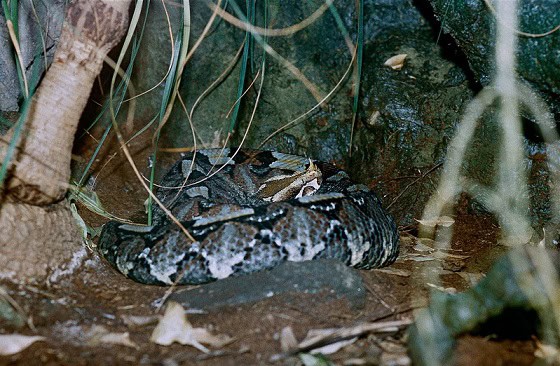
You might think that only an idiot could fail to spot these mesmerising fungi shades, but in the forests of central Africa, butterfly vipers completely vanish in the jungle. Their camouflage is supreme, more than matching their puff adder cousin.
In fact, the funkier colours seem to be an adaption to living more commonly in rainforests and swampier forests, and rarely drier areas, whereas the duller puff adder can be found by game trails and drier thickets near villages. This snake isn’t suffering by being a show-off; it succeeds in being both fabulous and stealthy.
The exact vividness of the colours depends on their moult cycle. Maximum intensity is achieved immediately after shedding their skin. The refreshed butterfly viper will be adorned with crimson, blue, yellow, and rich brown, with a javelin shaped black marking atop the head. This is similar to an actual butterfly, emerging from its cocoon. The more time then passes, the drabber Bitis nasicornis becomes, before the cycle renews. There’s some variety by region, as those further east in Africa tend to be darker.
| 4 | Venom description (dangerous) |
Butterfly viper venom contains virtually no neurotoxins, but ticks all the typical boxes for vipers. Its venom is haemotoxic, destroying cellular compounds within the bloodstream. It triggers spontaneous haemorrhaging, and is highly cytotoxic, leading to the formation of necrosis and severe swelling, similarly to the average rattlesnake. The venom also contains myocardiotoxins, which target heart tissue, damaging cardiac function and causing blood pressure to plummet like a broken elevator.
At 20-30mm, butterfly vipers have extremely long fangs, though not quite matching the gaboon adder’s 50mm. Similarly, their venom yield falls short of the gaboon adder’s voluminous 200-1000mg, but still averages at 200mg per bite. The elegant sea snake produces just 5-9mg. The necrosis is less severe than with the puff adder, but per drop, the venom is more lethal. Arrhythmia is a more unusual symptom of a butterfly viper bite.
Luckily, two antivenoms are manufactured in France which include antibodies raised against butterfly viper venom: Ipser Africa® and Anti-Bitis-Echis-Naja Africa®. An African antivenom also uses butterfly viper venom, called Saimr Polyvalent Snake Antivenom®.
| 5 | Comparison: gaboon adder |
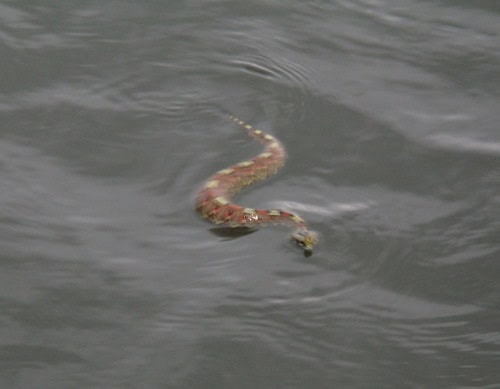
Butterfly vipers share a huge swathe of territory with their relative, the gaboon adder (Bitis gabonica). Both inhabit forests and both stretch from Nigeria to Uganda. There’s several clear differences, as Bitis gabonica is still immensely thick, but lacks the 3-pronged horns of butterfly vipers.
Gaboon vipers are generally larger, reaching 174cm, and lack the more fantastical fungi colours of the butterfly viper. The top of the head is pale in gaboon adders, lacking the black javelin mark. Both have a thick spinal stripe divided into light and dark sections, but in butterfly vipers, the light sections break inward in the centre. In gaboon adders, they’re more perfectly rectangular.
The two coexist in several locations, but have subtly different preferences to prevent punishing competition. A 2006 study found that while gaboon adders were happy in secondary forests, forests which had been altered by mankind, butterfly vipers were most abundant in mature rainforests and swamp forests. They preferred the most ancient, untouched rainforests, not ones with tree stumps and wood piles still lingering around.
| 6 | Diet: mostly mammals, some frogs |

Gaboon adders also have a tendency to appear in cashew and tea plantations, which is rare for butterfly vipers. Essentially, they’re much less likely to appear in areas modified by mankind. Meanwhile, a 2003 study by the same team compared the species’ diets. The sample size was huge, containing 392 butterfly vipers, broken down into 48 subadults, 163 males and 161 females.
Gaboon adders (sample size 524) ate an abundance of small mammals, supplemented with lizards and birds, and occasionally frogs. With butterfly vipers, small mammals also predominated – confirmed prey include the Gambian rat and typical striped grass mouse. But they ate far more frogs than gaboon adders, giving them a resource which their rival rarely exploits.
This fits with the observations that butterfly vipers tend to appear near water bodies within dense forests, whether it’s swamps, small pools or rainforest rivershores. The British originally dubbed them “river jack” during colonial times. Confirmed amphibian prey of butterfly vipers include the flat-backed toad and hairy frog.
| 7 | Reports from captive keepers |
Butterfly vipers have also been recorded eating fish in the wild. In captivity, they happily eat a diet of mice and rats for years. However, like all Bitis members, butterfly vipers are exceptionally lazy ambush predators. Any captive keeper must find a way to hijack their natural instincts, which are to wait for days or even weeks, then suddenly pounce on an alive mouse scurrying past a few feet away.
According to a 1997 report, butterfly vipers happily accept pre-killed rodents if placed a few inches in front of them, then prodded slightly to mimic movement. However, they don’t respond to “feed-teasing”; when their body is gently touched with the prey at different points. According to the keeper, butterfly vipers are easy to overfeed due to their lethargic nature. His recommendation was to feed neonates a fuzzy mouse every 10-12 days, and adults a large rat every 12-14 days.
In another report, one captive was so shy that it refused to leave its hide box even if starving, and waited 3 days for a mouse to wander into its hide box before striking.
| 8 | A wacky bite story (Missouri) |
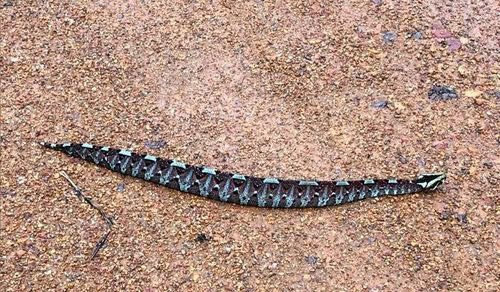
There aren’t many records for Bitis nasicornis, but two confirmed bites happened to the same 41 year old man, 2 months apart in 2002. The man lived in Kirkwood, Missouri, and was an exotic reptile keeper who had suffered 7 previous venomous bites, including from Mojave rattlesnakes and Malayan pitvipers. On April 2nd, a butterfly viper struck his right index finger, leading to intense pain, and an intensely swollen finger, hand and wrist after just 45 minutes. This shows how rapidly Bitis nasicornis venom can take effect.
The hospital acquired South African Polyvalent Antivenom from a nearby zoo, and successfully administered it to the victim. Then the man’s wife turned up, and became confused, as she didn’t realise he had ever kept venomous snakes. She then learned that the snake menagrerie was kept at his girlfriend’s house, which also confused her, as she didn’t know about the girlfriend. Shortly after, the man’s girlfriend turned up, and a fistfight broke out between her and the wife. The sheriff’s department was summoned.
While this was happening, the man was lying in a hospital bed with his swollen finger pointing skyward. By this stage, the butterfly viper was almost forgotten. The ICU doctor warned him that his wife would “take him out in the woods and blow his head off”. The man then signed out of the hospital against medical advice, and fled the state to avoid his wife.
| 9 | The only confirmed death |
The man returned to action on May 26th, 2002, with a new butterfly viper snakebite. The man was being airlifted to the ICU in St Louis, Missouri, suffering from respiratory problems, probably due to an allergic reaction stimulated by his previous bite history.
The man’s symptoms were less severe this time, and antivenom wasn’t administered. However, the doctor later discovered that because the man fled the hospital so quickly originally, the tip of his finger had grown necrotic. This required a full finger amputation several months later in 2002. There was no mention of whether his wife had tracked him down.
There’s almost certainly been African woodsmen killed by butterfly vipers in centuries gone by, in cases long lost to time. But the only confirmed fatality in medical records happened to a 48 year old firefighter in Dayton, Ohio. The man had experience in keeping exotic reptiles, yet was bitten on the left hand while closing the terrarium of his 28 inch, 3 pound butterfly viper. His wife drove him to the hospital, where the man was unconscious upon arrival. Details are thin, but a “chain of mishaps” apparently led to his death at 24 hours post bite. This bite occurred on August 3rd 2003.
| 10 | Warning: Ghanaian super-hybrids |
Everyone knows that grizzly and polar bears can form hybrids called the grolar (or pizzly), since they only diverged 500,000 years ago. There’s also evidence that butterfly vipers can interbreed in the wild, with rhinoceros vipers (Bitis rhinoceros) or gaboon adders (Bitis gabonica).
The discovery dates back to a 1968 report, which itself reanalysed a butterfly viper specimen stored in Rijksmuseum museum in the Netherlands, originally collected in Ghana in 1843. This individual had a strange mixture of characteristics. For example, the savage three-pronged horns were clearly in place, but less developed than usual. Yet its facial patterns were more like a gaboon adder, as that species has a temporal triangle (a dark triangular patch spreading from the jaw) which butterfly vipers never have.
The individual had a dark jawline spot found only in rhinoceros vipers. Yet the preserved snake also had the dark javelin-shaped mark atop the head, a classic characteristic of butterfly vipers, and found in no other Bitis members.
There were some elements, such as more gently keeled scales, that could be explained by being a juvenile. But the differences in pattern had no explanation other being a hybrid, and a hybrid was therefore the author’s official conclusion. The report deemed it to be a gaboon viper crossbreed, but gaboon adders have since been split into two species: those in Ghana where the hybrid was collected are now rhinoceros vipers, so that’s where 50% of this crossbred individual originated from.
